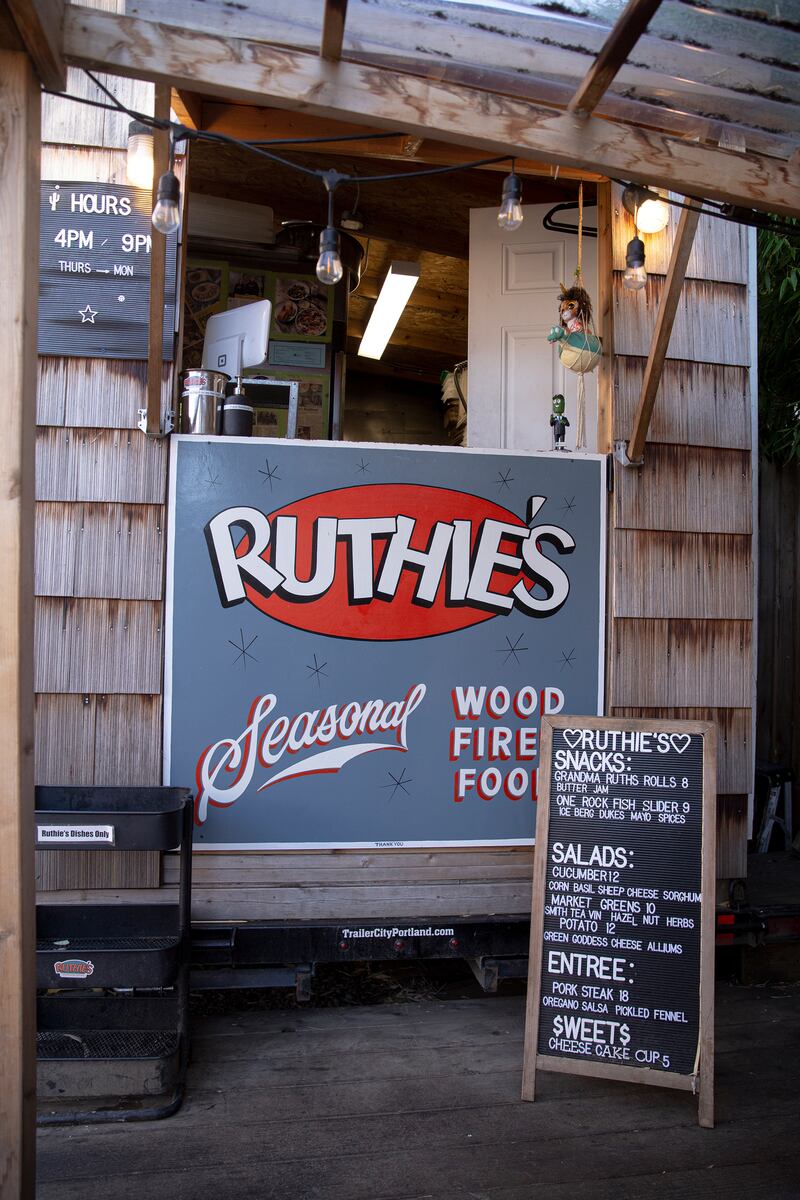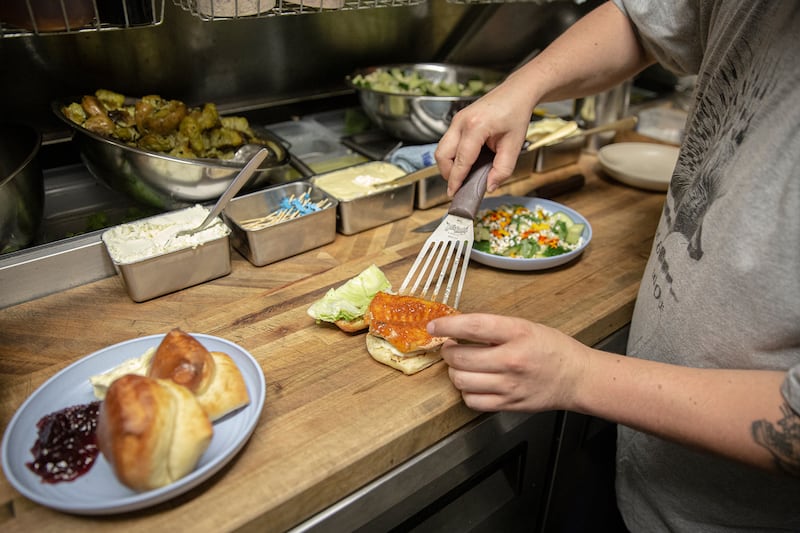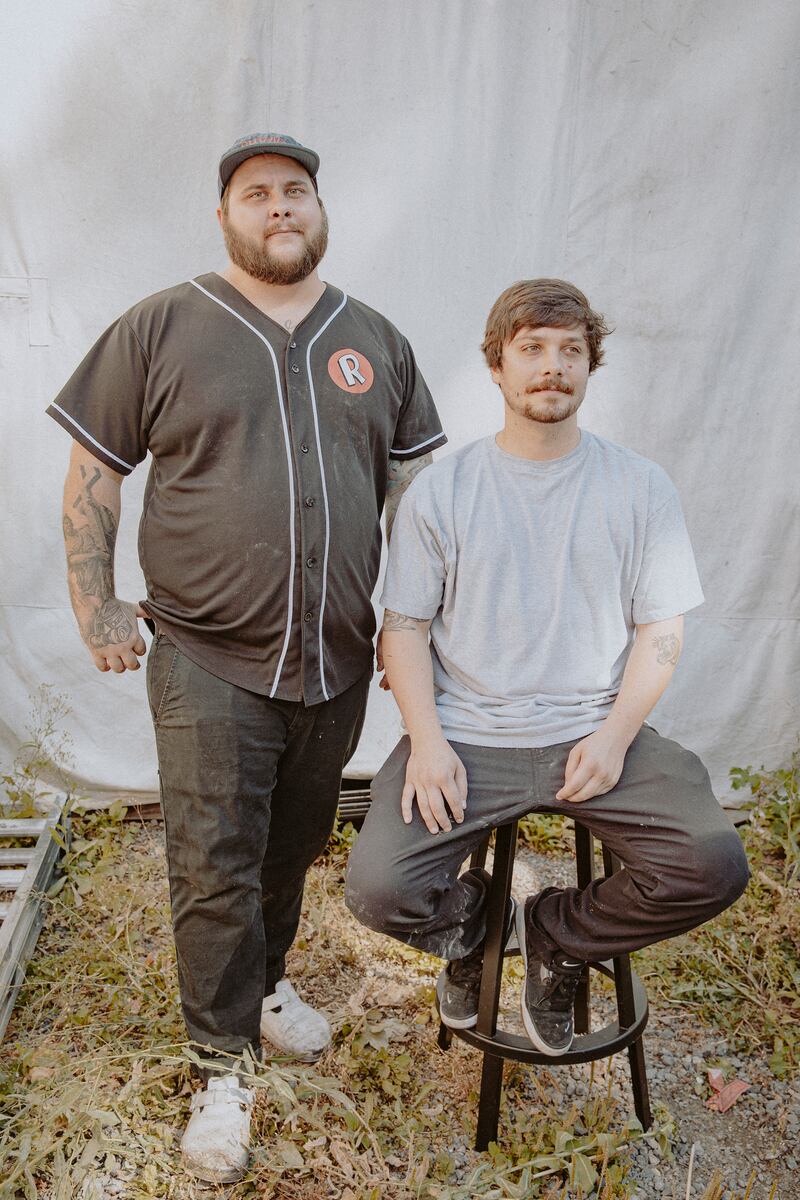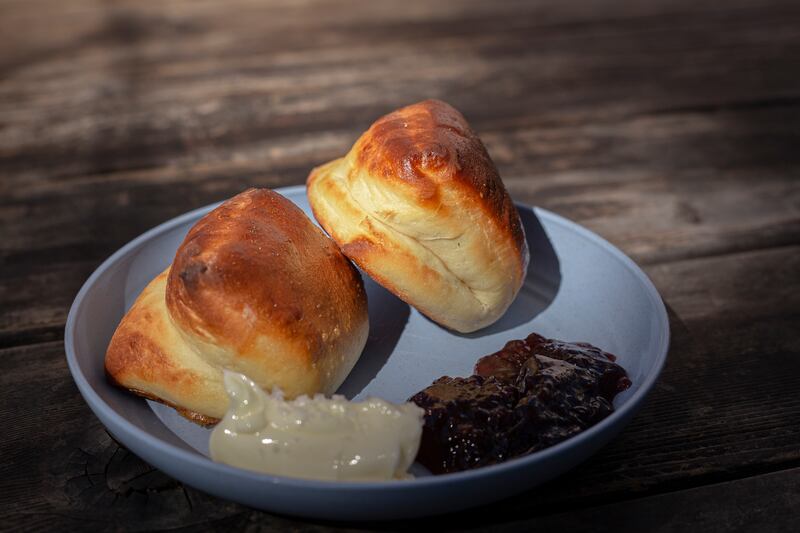These days, Collin Mohr is a long way from home. But a taste of home is never too far away. In fact, it’s the first item on the menu at Ruthie’s, a Portland food cart named in honor of Mohr’s grandmother, which he co-owns and operates. She taught him to cook and to appreciate good food, so it’s only fitting that Grandma Ruth’s rolls would lead the way. They’re fluffy and sweet, with a buttery-brown crust and top-and-bottom halves that resemble a thick, tightly closed book with glistening shells. Mohr, who is also the chef, follows his grandmother’s recipe to the letter, even importing flour and honey from Utah to keep it authentic.

Those rolls may sound familiar to readers from the Intermountain West or those who have ties to the region, and even to tourists who’ve dined at the Lion House in downtown Salt Lake City. Under different names, with subtle variations, rolls like these are a staple for many families with a Latter-day Saint heritage, and a key ingredient for family gatherings, from weddings and funerals to Thanksgiving dinners. And now, they’re a year-round bestseller at Ruthie’s, often alongside other options with an intermountain flavor, from a refined version of “funeral potatoes” to a modern take on Grandma Ruth’s broccoli-cheddar casserole, all prepared with a farm-to-table ethos.
All this is served from a single window in a blocky trailer with ragged brown shingles for siding. Ruthie’s rests in the back corner of a courtyard in the trendy Richmond neighborhood, where strings of light shine over a series of brown picnic tables. Mohr and his childhood friend, Aaron Kiss, both moved to Portland from South Ogden, Utah, in the early 2010s — at least in part to put some distance between Mohr and the small town that shaped his childhood. There, he was the kid who never went to church, though his grandmother did. That became his identity. He carries it with him here, but fits in quite well, with his scraggly beard and colorful tattoos peeking out from under a baseball jersey. But there are certain elements you can’t leave behind. When he and Kiss decided to start a food business, drawing on their cultural background was a no-brainer.
In two short years, this approach has earned national acclaim for what Willamette Week calls “Mormon cooking,” with endorsements from Portland Monthly and the Los Angeles Times. When the Netflix travel show “Somebody Feed Phil” visited in May, host Phil Rosenthal introduced the subject as “a cuisine that I didn’t know was a cuisine.”

That raises an interesting question. What even is a cuisine? We often talk about cuisine in terms of nationalities, ethnicities or regions; large groups of people whose traditions and geographic circumstances have shaped their cultural values, specifically how they source, prepare and eat their food. But what if a food culture comes from a people who don’t quite fit any of these categories? Who, like Mohr, don’t always neatly fit the categories they place upon themselves? Can that cuisine help us to understand who they are and what values they share? Or does the food itself somehow help to shape their identity and hold them together?
Collin Mohr and Aaron Kiss grew up as best friends in Ogden, Utah. They moved to Portland in search of something new, but their homeland ended up inspiring their first restaurant.
“A cuisine is a group of somehow interrelated foods that have sprung up in concert with a particular culture,” says David Page, author of the recent book “Food Americana,” which explores the country’s unique culinary traditions. For example, Page is Jewish; brisket, while cooked in many ways in many places, has unique roots in certain Jewish communities. Roots tend to grow regionally. Consider Italy. While Americans have a clear understanding of what qualifies as “Italian food,” Sicilian cuisine, Tuscan cuisine and Venetian cuisine are all very different. “Over time, the creation of an Italian country in some degree brought those cuisines together,” he adds. “But there are still marked differences between areas.” So, too, in America.
Barbecue is another beloved example for Page, who also created the “Diners, Drive-Ins and Dives” television series hosted by Guy Fieri. Originally imported from the Caribbean, barbecue became the distinctive cuisine of the southern United States. But there are many regional variations — from Texas to Memphis, St. Louis to the Carolinas — with their own distinctive flavors and methods, varying spice or smoke or sauce. In each version, the differences are what form the foundation of a budding cuisine, reflecting the circumstances or values of the people it feeds.
Food is similar across much of the Midwest — Utah is not the only state that loves cheesy potatoes and yeast rolls — because its communities had something in common. “The center of events was a religious establishment,” Page says. “So much of what’s served communally at, say, a church breakfast or a synagogue brotherhood meeting is not the expensive end of the stick. It’s the stuff that you can put together, whatever your economics, for a large group of people.” Within those environs, whether Lutheran or Methodist or Catholic, cheap ingredients that were readily available took on new mutations as each community slowly but surely made each dish their own. “Cuisines can be self-defined,” Page says. “If a cuisine is representative of your particular group or interests, I’ll give it to you.”
In that sense, Ruthie’s reminds Page of a New York restaurant called Bubby’s — a kosher staple named after the Yiddish word for grandmother — that serves up traditional Jewish favorites. But Ruthie’s also shows how cuisines tend to change over time — especially in the era of globalization. “The Reuben sandwich, which is seen as a deli special, is not kosher,” he observes. “It mixes meat and milk. So at what point is authenticity authentic?”
Perhaps the answer is utilitarian. How does food bring communities together? “It’s the original uniter,” Page says. “Once we figured out fire, we sat around the fire carrying mastodon parts, or whatever. It is where you talk. It is where you exchange thoughts, feelings, views. And it is the best way to come together.” Riffing on the ancient Greek philosopher Epicurus, Page argues that eating together is even central to what it means to be human: “You should decide who you are going to dine with before you decide what to eat,” he explains. “Because eating alone is like being a wolf.”
“We want to take something to the potluck. We want street treats where everyone comes out on a Sunday night and shares. Shareable meals are signatures.”
On a summer afternoon at Ruthie’s, a sharp knife chop-chop-chops against a dull board just out of sight, resonating across the courtyard. The stream from a high-pressure hose hisses against dishes. Plumes of smoke puff from the wood oven, splashing the patio with oaken perfume. Soon, Mohr will serve up more heaping plates of rolls alongside pools of jam and piles of fresh butter. When he does, he shares more than food, because these rolls always transport Mohr back to his youth. It simply wasn’t a family gathering without them; his uncle John was even known to protest if they were absent.
Mohr always felt out of place in South Ogden, an outsider among neighbors and even relatives who belonged to The Church of Jesus Christ of Latter-day Saints. Eager to find his own way in the world, he moved to Portland to attend the Le Cordon Bleu culinary school when he was 18. Kiss followed him three years later. For several years, they worked at various eateries, before Covid-19 presented them with a dilemma. In 2020, as the economy tanked, Mohr lost his job. Kiss wasn’t very happy with his. When an acquaintance offered to sell them an empty food cart, they took him up on it before they even had a plan.

The name came to them first, in a long-running brainstorm session. They liked how it felt, mostly, as a tender homage that was fittingly intimate for the space. It was only later that they realized the name brought with it an entire concept that was both personal and much bigger. Grandma Ruth had a book that was special to her, almost sacred within the confines of the kitchen. The ward cookbook gathered the culinary knowledge of members of her congregation, before it was passed down between generations and perfected with pencil marks over time. It formed the foundation of every family gathering, every afternoon spent in her kitchen, where Mohr learned to appreciate how food can bring folks together. Now, it would do the same for Ruthie’s.
Carrian Cheney wrote the book “Raised in the Kitchen” about modern family cooking. A Latter-day Saint from Farmington, Utah, she describes the characteristics of her people’s cuisine in terms of houses: You have modern houses, you have traditional houses and then you have various combinations that take elements from each. “What’s something that their great-grandma made that they’ve slightly adapted to fit the culture right now,” she asks, “but couldn’t lose the recipe because it’s grandma’s?”
The very idea of a ward cookbook implies a unique identity. More than a how-to manual, it’s an effort to preserve the collective memory, to immortalize the group’s cultural staples and share them with future generations as a sort of oral history written in lists of ingredients and step-by-step directions. Indirectly, it catalogs and categorizes what makes them who they are. Perhaps even more importantly, it reveals something unique about Latter-day Saint culture that expresses itself through food.
If you asked Cheney’s kids about their favorite kitchen memories, they would probably point to the process of making her own patented potato rolls. “There’s something about getting your hands in dough, and feeling that breath that comes from it,” she says. “When you’re standing side by side in the kitchen, doing something where your focus is completely on your hands and on food, all the walls drop, and you just suddenly start talking and sharing.”
“Sitting around the fire is where you talk. It is where you exchange thoughts, feelings, views. And it is the best way to come together.”
The phenomenon reminds her of her mother’s Dutch oven peach cobbler, typically simmered atop a campfire. After a long day of hiking and exploring, she’d return to their temporary dwelling to find it waiting for her, under a starry night, served up with an orange-tinted twilight chat with her mom. “There was magic when that happened,” she remembers.
Beyond the apparent thrift and simplicity, it’s that sense of connection, of family and community, that lies at the heart of Latter-day Saint cuisine. “We want to create things that can be shared with others,” Cheney says. “We want to take something to the potluck. We want to have street treats where everyone comes out on a Sunday night and shares something. Shareable meals are signatures.”
She’s seen it many times, most of all among her family. “There is something about when you sit down with someone and share something that hits all the senses — I’m convinced there is something there,” she insists, “when you’re smelling, tasting, touching and you’re enjoying a conversation together. Somehow it seems to become a moment and a memory, and you have a real connection.”
After the episode about Ruthie’s aired on Netflix, the spot was overrun with Latter-day Saints and Utahns far from home. They descended on Portland from the outskirts, from small towns like McMinnville and Wilsonville, braving a neighborhood that is at least visibly notable for the proliferation of open-toed Birkenstock sandals, just to get a taste of home. The dramatic irony that a sort of prodigal son would become the chef who could deliver that is not lost on him. “They’ve shown up in full force,” Mohr says. “And they’re referencing Ogden High or Bonneville or something like that. It’s just surreal.”
Ruthie’s menu changes often, with whimsical choices like shokupan — a soft Japanese bread — or dinosaur-shaped chicken nuggets, served with ranch powder and caviar. But the shack is lined with colorful jars of canned and preserved salad accessories, and the ward cookbook’s influence shows through in hearty winter dishes when fresh local produce isn’t as available. Sometimes, Mohr and Kiss deconstruct the classics, like the broccoli-cheddar casserole — keeping the core of hash browns, broccoli, cheddar and curry powder, but fire-roasting the broccoli in their wood oven, using locally sourced potatoes and cheese, and importing their spice mix from India. “Food is competitive. You have to change,” Mohr says. “Take something simple and make it fun.”
That’s not unlike the childhood Mohr remembers. “You’ll go to a normal get-together, and there’ll be four different varieties of potatoes, and three different varieties of a Jell-O salad, and a couple of different casseroles that are all familiar,” Mohr explains. “That’s what I grew up going to. It was amazing food, and you always knew it was gonna be a good time.” Even so, such dishes elicit not only the flavor of home, but its memory. Sharing them isn’t just about passing on a family tradition — it’s about passing on the surrounding experience. “The fact that we can get people to sit down at a table, share a moment with each other, put their phones away and enjoy a meal together,” Mohr says, “you know, that’s what it’s all about for us.”
Ruthie’s also has the most important endorsement of all, from Grandma Ruth. She’s never traveled here, but her grandson sends her pictures regularly. That tie is essential to the project, Mohr says. “It’s a creative outlet and a memory.” One he tries to re-create every evening. Tonight, as he brings out an order of rolls for a mother and her son, he sets the mood: “My grandmother’s rolls there for ya,” he says, reading their expressions as he does. “To see people have the same reaction I had when I was a kid — it’s just the most humbling moment. Those rolls, to me, are my childhood. It doesn’t get any cooler than that.”
This story appears in the October issue of Deseret Magazine. Learn more about how to subscribe.


